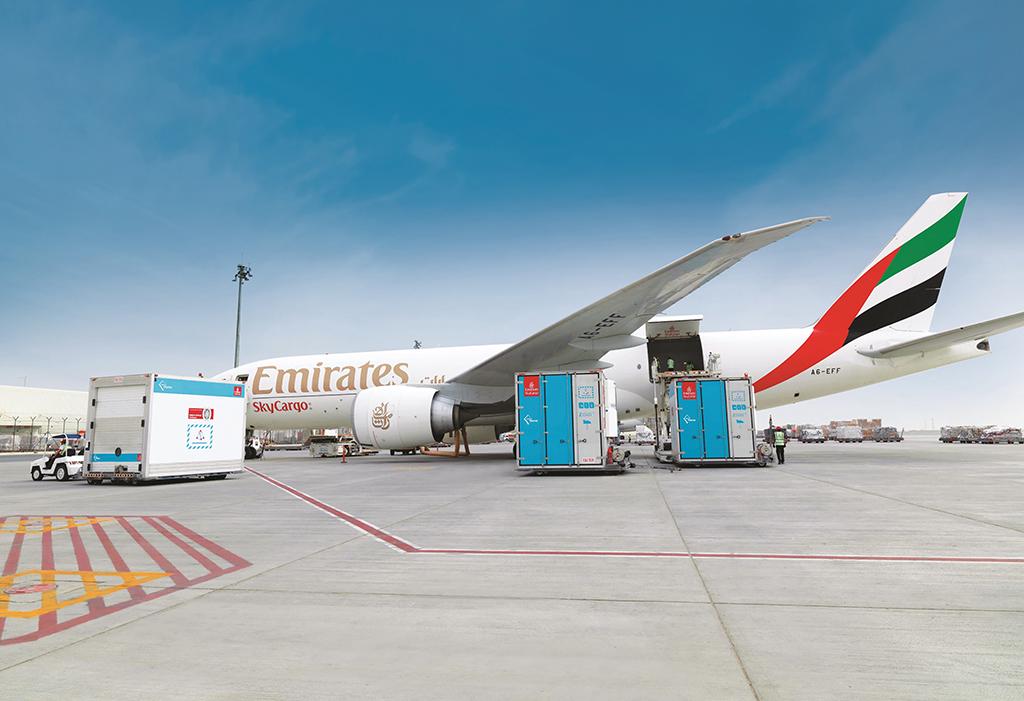
Around a year into the air cargo industry’s biggest challenge ever—transporting billions of doses of vital COVID-19 vaccines around the globe—operators are proud of how they have risen to meet that need, while recognizing that obstacles remain in the ongoing mission.
With COVID-19 case numbers high again in many countries, some new restrictions in place and the omicron variant spreading alarmingly, the beginning of 2022 is not looking as positive for the broader aviation industry as many had hoped even just a few weeks ago.
- Air cargo capacity down 7.2% from pre-pandemic levels in October
- Omicron effects could put further pressure on belly capacity
- Pharmaceutical transport demand is growing strongly
For air cargo, as the importance of COVID-19 vaccine booster doses tops the news agenda, the effort to transport vaccines around the world is in the spotlight once again. But hopes are flagging that a return to increased long-haul passenger activity might ease pressure on cargo capacity in the short term.
Since the pandemic began, the air cargo industry has tackled many issues to ensure the smooth distribution of COVID-19 vaccines, starting with the first shipments in late 2020.
The International Air Transport Association (IATA) says that is due to early preparation-—and coordination.
“Air cargo has prepared itself very, very well and has been extremely successful in what was and continues to be the largest coordinated vaccine movement ever,” says Brendan Sullivan, global head of cargo at IATA. “A lot of this was based on the experience we’ve had over a number of years in pharmaceutical movements and translating that to the COVID-19 vaccine. We worked early and brought together all the key stakeholders.”
At an individual level, airlines, operators, specialized manufacturers and other players have been taking the initiative to ensure demand for transporting vaccines continues to be met.
Airlines have been adding and upgrading the specialized facilities needed to transport temperature-sensitive goods around the world.
That investment is not just related to COVID. “Pharmaceutical air cargo volumes have been growing year-over-year for the past 5-10 years, and we expect that to continue,” says Marcel Kuijn, global head of pharmaceutical logistics at Air France KLM Martinair Cargo. The airline has transported 85-90 million doses so far, though COVID-19 vaccines only represent a small proportion of its overall pharmaceutical business, he adds.
By early December, Emirates SkyCargo had transported 600 million doses of COVID-19 vaccines, says Julian Sutch, head of global pharma sales. He predicted strong demand for transportation of the vaccine will continue into 2022—as well as strong demand for other pharmaceutical activities.
“It’s dramatically ramped up, matching the ramp-up in production. We started moving them in October [2020] but in very small numbers. It’s been in the past four or five months that volumes have really started to pick up.”
That strong demand for COVID-19 vaccine transportation is set to continue, Sutch says, as is demand for pharmaceutical transportation in general. Emirates Airline’s broad network has helped SkyCargo transport such a large number of doses, he says.
Early on in the pandemic, Emirates SkyCargo made the decision to expand its facilities in Dubai to ensure it could meet the expected demand for pharmaceuticals transport, including adding cool cell infrastructure as well as working with ground-handling partners around the world and in some cases, such as in Chicago and Copenhagen, working together to build more pharma facilities.
The operator is still making use of 16 “minifreighters”—Boeing 777-300s with their economy seats stripped out—to help meet demand, while its “passenger freighters”—passenger aircraft used only for their belly capacity—are still being used for cargo as well as gradually being deployed back into the passenger business as demand returns on some routes.

Coordination and communication are also key. Emirates SkyCargo implemented a new handling code for COVID-19 vaccine shipments, ensuring it could keep a close eye on their progress through its system.
Air France KLM Martinair Cargo has also been expanding its pharma facilities, Kuijn says. “In Schiphol [Airport in Amsterdam], at the beginning of the year, we implemented a new cool room that we built from scratch. That was done for two reasons: We anticipate growth in volumes driven by COVID-19 vaccines, but we also have an ambition to grow in pharma. So, even apart from COVID vaccines, we’re expecting higher volumes.”
The airline has also expanded its backup capacity at Paris Charles de Gaulle Airport. And although the airline has so far been able to cope with the volumes with its existing capacity, more investments in storage capacity are set in 2022 for both hubs, Kuijn says, with each set to get another new cool room.
COVID-19 vaccines are expected to become “a structural business, with quite some volumes for 2022 and the years to come,” he adds.
If COVID-19 vaccinations look ready to become a semipermanent—or even permanent—feature of the pharmaceuticals business, demand for non-COVID-related pharmaceuticals shipments is also likely to rise in the coming years.
The good news is that across the air cargo industry, the unprecedented challenge of transporting COVID-19 vaccines has led to progress and improved cooperation across the sector in many areas, which will help operators cope with both COVID- and non-COVID-related growth in years to come.
“We have over 400 [Center of Excellence for Independent Validators] pharmaceutical certified parties throughout the world. Largely this is still in the ‘Global North,’ so there are still some regions which are a little bit behind. But what we see there are deployments of solutions specific to transporting the COVID-19 vaccine—temporary solutions, in particular for on the ground where the infrastructure is most needed,” Sullivan says. He expects further progress on improving cold-chain infrastructure as well.
In one example of successful cooperation so far, IATA worked with the World Customs Organization (WCO) to identify items related to the pandemic for which customs processes should be streamlined.
The association also worked with Unicef, the COVID-19 Vaccines Global Access (COVAX) coalition of organizations and airlines to create partnerships, ensure all parties were prepared and aware of potential risks and bottlenecks and to help them plan for and mitigate problems.
Coordination among supply chain players including airlines, equipment providers and freight forwarders has been successful over the past months, says Niklas Adamsson, chief operating officer of temperature-controlled container specialist Envirotainer, which transported around 1 billion doses of COVID-19 vaccines in 2021.
“There’s been so much uncertainty, and we have known since the beginning that we would have to work with fluid timing because of approvals and government decisions. So it’s been short-term planning, and we have just had to be as prepared as we could,” he says.
To meet growing demand for transportation of all temperature-sensitive pharmaceuticals—not just COVID-19 vaccines—Envirotainer in 2021 launched its new Cryosure platform for shipments needing to be maintained at -70C (-94F).
“Of course, we’ve done this before,” Adamsson says, referring to earlier vaccine campaigns, which are a key part of the company’s—and the sector’s—usual business. “It’s just a question of time and pace.”
Envirotainer was involved in a campaign to transport COVID-19 vaccines to Chile, in conjunction with LATAM Airlines. Since it did not have a depot in Santiago, the company opted to set up what it describes as a “pop-up station” to keep the supply process for that program running as smoothly as possible and maximize utilization of its own and the airline’s equipment.
“I think the industry as a whole has shown a rather high degree of adaptability to this new situation, all the while doing our day-to-day job of transporting thousands and thousands of pallets of regular pharma. It’s been a hectic year, but we as an industry have been very successful,” Adamsson says.
One year on, the air cargo industry is justifiably proud of what it has achieved since the first COVID-19 vaccine cargo took to the skies in December 2020, but operators know the challenge is far from over, and the vaccine effort will continue in 2022 against the backdrop of many broader challenges for the industry.
The biggest of those is the capacity squeeze that has plagued the sector since the beginning of the pandemic. In October 2021, global air cargo demand rose 9.4% compared with October 2019, but capacity was still 7.2% below the pre-COVID level, with a still-depleted passenger network, constraints in the maritime sector and macroeconomic factors all contributing to a tense situation for operators.
“The impact of government reactions to the omicron variant is a concern,” IATA Director General Willie Walsh said as the October figures were published. “If it dampens travel demand, capacity issues will become more acute.”
While the capacity issues are likely to affect priority pharmaceutical shipments less than other business areas, the capacity conundrum is certainly making life more difficult for operators, in particular in areas such as China, where long-haul passenger networks are still struggling to recover in the face of ongoing restrictions.
“It’s really critical that people coordinate and plan for that reduced capacity,” Sullivan says. National authorities should seek to harmonize any travel-related health measures to minimize the impact on passenger flights and therefore belly capacity, while vaccine manufacturers, forwarders, ground handlers and airlines should also seek to work together as much as possible, he notes. “Capacity on the ground is also constrained, so bringing all these parties together is what is going to make sure we can continue this successfully,” he adds.
In the longer term, the COVID-19 pandemic seems to have sparked a renewed focus on freighter operations, feeding through into new freighter propositions and strong demand for conversions. But that ongoing rebalancing of capacity will not take effect immediately, leaving operators still reliant on belly-hold space.
However, one side effect of the pandemic—and the shipping of COVID-19 vaccines in particular—is that it has positively affected perceptions about the air cargo sector. Air cargo has been in the spotlight now for two years, and cargo executives hope that the newfound attention on the vital role air cargo plays will translate into increased focus—and investment—in years to come.

